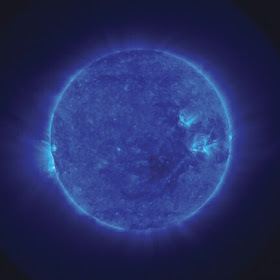 This blog commences a series of posts to do with aspects of advanced astrophysics.
This blog commences a series of posts to do with aspects of advanced astrophysics.
What exactly is a star? Basically it can be thought of as an immense, controlled fusion bomb, bound by gravity. It manufactures heavier elements through the nuclear fusion process and generates heat and light as a result.
With regard to this, it’s a of interest to note we have more confidence regarding the nature of the physical interior of stars and the Sun than the interiors of planets like the Earth. The reason is that the physical laws to be applied are simpler once one is dealing with an ionized gas or plasma.
P = (N o + Ne) k T
Where N o is the number of atoms of all kinds, both neutral (unionized) and ionized and Ne is the number of free electrons (the greater this number, the higher the degree of ionization). The total gas pressure therefore is the sum of the two partial pressures:
P = N o k T + Ne k T
The second term is known as the ‘electron pressure”. Then the ratio between the gas and electron pressure is:
P/P e = 1 + N o / Ne
An alternative way of expressing the stellar gas equation of state is:
P = (r/ mH) kT = r RT/ m
Where r is the gas density and m is the mean molecular weight, with H the mass of the hydrogen nucleus or about 1.7 x 10-27 kg)
An expression for m in terms of the chemical composition of a star may be arrived at from a simple tabulation involving the number of atoms of the relevant elemental species and the numbers of free electrons arising from their respective ionizations.
X + Y + Z = 1
Where X denotes the fraction of hydrogen, Y the fraction of helium, and Z the fraction of all the heavier elements. The number of electrons and the number of atoms can then be set out for hydrogen (X), helium (Y), and heavier elements (Z). For example, both the number of electrons and number of atoms is equal to: Xr / H In the case of hydrogen. Why? Well, because there is exactly one electron and one proton - no neutrons comprising it. In the case of helium, the no. of atoms is: Yr / H and the number of electrons can be written: 2Y r / H. In the case of heavier elements, the no. of atoms can be written Zr / H and the number of electrons as: ½AZr / H. Therefore, we may write:
N (total) = (2X + 3Y/4 + ½Zr / H)
And finally, after simplifying, the mean molecular weight of the stellar gas-plasma is:
1/ m = (2X + 3Y/4 + ½Z)
For most stars to which we will apply the above equation of state, Z represents only a negligible fraction (e.g. in the Sun about 0.2% or 0.002)so we can therefore simplify further:
Thus, let Z = 1 – X – Y so:
N(total) = r /H(2X + 3Y/4 + (1 – X – Y)/2)
N(total) = r /H (3X/2 + Y/4 + ½ ) = r /4H (6X + Y +2)
Or: m = 4/ (6X + Y + 2)
This is a good approximation except in the cool, outermost layers of a star. Then since Z is negligible we may replace Y with (1 – X) and obtain:
m = 4/ (3 + 5X)
Problems for the budding astrophysics maven:
1) In the atmosphere of a star at a particular layer, the temperature is 5650 K and there are approximately 1.45 x 10 19 free electrons. If the total gas pressure is 8.3 x 103 Pa find: a) the electron pressure, and b) the total number of neutral and ionized atoms.
2) Find the molecular weight at the bottom of the convection zone of a main sequence star for which X = 0.9 and Y = 0.1, approximately.
3) Using the formula for the molecular weight, show that for electrons only: m = 2 / (1 + X).
No comments:
Post a Comment